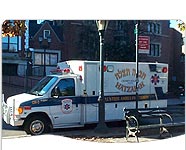 
Bio-Barcode Assay: A Promising Tool for Early Detection of Alzheimer's Disease
By Tom Ewing , MedPage Today Staff Writer
Reviewed by Zalman S. Agus, MD; Emeritus Professor at the University of Pennsylvania School of Medicine.
February 02, 2005
News Article: MSNBC, CNN
Review
At present, there is no definitive diagnostic method for Alzheimer's disease other than postmortem
identification of senile plaques and neurofibrillary tangles in the brain.
Pre-mortem diagnosis is currently based on a patient's clinical history, in vivo brain imaging,
and neurological tests, but this approach has proven to be only about 85% accurate.
Over the years, researchers have attempted to detect soluble markers for Alzheimer's in living humans.
However, one of the methods, involving the measurement of tau protein or amyloid-beta protein concentration
in cerebrospinal fluid or plasma, is hampered by significant overlap of such markers in healthy and unhealthy
people and, therefore, has yielded inconclusive results.
With the other method, which targets only pathogenic markers such as cleaved tau protein, phosphorized
tau protein, or amyloid-beta-derived diffusible ligands (ADDLs), the concentrations of such markers in cerebrospinal
fluid are so low in the early stages of Alzheimer's that they cannot be identified accurately with conventional ELISA
or blotting assays.
Now, according to a report published in the recent edition of the Proceedings of the National Academy of
Sciences, researchers at Northwestern University have employed a technique for measuring the concentration
of ADDLs in the cerebrospinal fluid of living humans that they consider to be a major step forward in early Alzheimer's
diagnosis.
Using a method called ultrasensitive nanoparticle-based bio-barcode assay, the researchers were able to
determine the approximate concentration of ADDL, a toxic protein, in cerebrospinal fluid taken from 30 individuals.
Fifteen of the subjects were deceased and were diagnosed with Alzheimer's through postmortem analysis of their
brains. Fifteen of the subjects were living, age-matched controls who did not have the disease.
Thanks to the bio-barcode assay's extraordinary sensitivity, the researchers were able to determine that ADDL
concentrations in the cerebrospinal fluid of the subjects diagnosed with Alzheimer's were consistently higher than
the levels of this biomarker in the living, undemented subjects.
The researchers noted that they would like to develop the bio-barcode technology so that testing could be done
using a blood or urine sample instead of cerebrospinal fluid, which is more difficult to obtain.
William L. Klein, a professor of neurobiology and physiology at Northwestern and a member of the research team,
commented, "In the last three years, there has been a big effort in Alzheimer's research to identify and detect biomarkers
in CSF. We think the accumulation of ADDLs is likely to be the first [of these], and now this extraordinarily powerful
detection technology has changed what we think might be possible."
|









